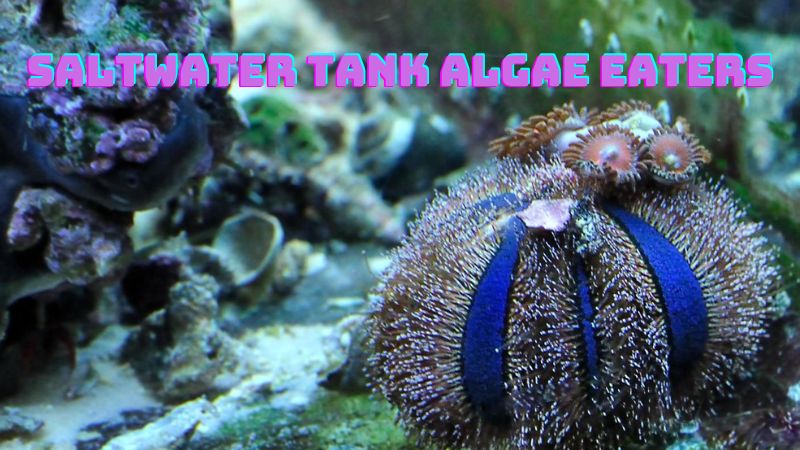Maintaining a sparkling clean saltwater tank can feel like a constant battle against algae. While a small amount of algae growth is natural, excessive amounts can cloud the water, smother corals, and create an eyesore. Fortunately, there’s a squad of saltwater superheroes ready to wage war on unwanted algae: algae eaters! These fish, invertebrates, and even some sea creatures can help keep your aquarium clean and balanced. The article Tropical Fish Haven introduces you to the saltwater tank algae eaters that help keep our aquariums algae-free.
Saltwater Tank Algae Eaters
Algae blenny
Algae blenny fish, scientifically known as Salarias fasciatus, are fish designed to consume algae, which are active on every surface in the aquarium. They may dive face-first into rocks, tank glass, and other surfaces to scrape off algae, often leaving visible “tail kisses” on the tank glass. The algal blenny, also known as the grass-cutter blenny, and members of the star blenny family, are dedicated to the relentless consumption of algae.
Keeping algae blenny fish in clean aquariums, without an algae supply, can pose a risk to them, causing them to gradually become lean and weak due to lack of nutrition. This shows the importance of providing them with enough algae in their natural habitat or aquarium.
Blenny fish of the genus Ecsenius also make excellent aquarium companions, including species such as Midas and Bicolor, as well as Tailspots, which are algae-eating experts with surprising abilities.
Zebrasoma tangs
The genus Zebrasoma includes many important aquarium tang species such as Yellow Tang, Purple Tang, Sailfin Tang, Black Tang, Scopas Tang, and Gem Tang. All are excellent algae eaters and are completely safe for coral environments.
If the ban is lifted, choosing Yellow Tang will never be a wrong choice, with its bright yellow color, diverse colors, active personality, not too aggressive, and moderate size. You can easily buy them from stores that specialize in aquariums. Additionally, you might also consider the Sailfin Tang, Scopas Tang, Purple Tang, Black Tang, or Gem Tang.
If you desire convenience, perhaps just choose a Zebrasoma and they will be hard at work throughout the day, munching on algae and attracting the attention of every visitor to your aquarium.
Rabbitfishes
Rabbitfish are excellent algae eaters and are reef-safe at the same time. Foxface, also known as Siganus vulpinus, is a popular choice for most reef tanks thanks to its bright colors, easy identification, and reasonable price. However, if you want a more distinctive option, you might want to look at Onespot, Magnificent, Goldspotted, or Virgate to create a vibrant coral look. Remember to keep only one fish per tank to avoid conflicts, and always be aware of the toxicity of their dorsal spines.
Acanthurus spp.
The Acanthurus family of tangs and spiny fishes also includes many well-known algae eaters, and they are often observed feeding directly on natural coral reefs. When starting out, you should consider isolation, and then perhaps choose one of the species such as Powder Blue, Powder Brown, Whitecheek, Achilles, or Convict. Avoid keeping A. lineatus and A. sohal in most tanks as they grow up to 15 inches in size and tend to become aggressive and territorial as adults.
Bristletooth tangs
Bristletooth tangs belonging to the genus Ctenochaetus are highly regarded as effective algae-eaters in reef aquariums. They possess a peaceful temperament compared to other tangs and display an unrelenting appetite for algae. There is anticipation for the magnificent Chevron tang and Kole tang to potentially return if the Hawaii ban is lifted. In the absence of these options, consider the Tomini tang, Silverspot tang, or Whitetail tang as suitable alternatives. It’s worth noting that larger, atypical Bristletooth tangs are becoming more prevalent in the trade, though their distinctive blotching patterns may fluctuate or even fade within a short span of days.
Snails
The humble sea snail can be found on shorelines and in rock pools around the world, feeding on short algae from flat rock surfaces. In tropical marine aquariums, there are several genera of snails including Tectus, Trochus, Turbo, and Astrea, all of which are very effective eaters of algae from rock surfaces and tank glass. When introduced into the aquarium, they should be placed on flat surfaces so they can grip and avoid the risk of being overturned and eaten by hermit crabs. Provided good water conditions and suitable food, they can breed in tanks. Stomatella snails are wonderful animals that can live on rock and coral surfaces, they help clean the tank effectively and can grow naturally.
Hermit crab
Care should be taken when adding hermit crabs to an aquarium that already uses snails for grazing, as these omnivorous crabs may attempt to hunt snails and use their empty shells as a home. However, if you can find small, reef-safe hermit crabs, their presence in the tank and constant grazing behavior can have a positive impact on the reef tank environment. , as verified by working with commercial suppliers to test their ability to eat algae.
Urchins
Sea urchins are expert algae eaters, capable of handling many types of algae and even lime deposits. They often collect debris and place it on their backs, some species can be venomous and can bite through cables, however in general their role is positive when cleaning larger reef tanks and removing harmful algae from rock surfaces, making coral growth and encrustation more favorable.
Sea Hares
Sea hares are sea urchins that feed heavily on algae, which can have a significant impact in as little as 24 hours if provided with the right algae. In fact, they are very effective at consuming algae, being able to clear an area of algae but are often turned back when there is a serious algae shortage in stores. Sea hares are often trapped in powerful wave pumps, causing death in some cases, and can excrete red or purple ink when stressed. So it’s best to give them the algae you want them to eat and when they’ve consumed it all, replace it with new algae.
Copepods
Not new to the hobby, but the introduction of live copepods can be helpful in preserving new aquariums with diatom and green algae infestations, helping to clean rock surfaces and tank bottoms during the initial harmful algae stage. Of course, fish will eat raw copepods, and you’ll need to supplement them in fairly large quantities to achieve the desired effect. However, regularly adding live copepods can benefit the ecosystem in a reef tank, as they are not only a food source but also provide nutrition to corals and fish such as fish. Hong Man Stone.
Conclusion
Saltwater tank algae eaters come in a variety of shapes, sizes, and personalities. From the grazing prowess of tangs to the meticulous cleaning of snails, there’s an algae eater to suit every aquarium. Remember, these creatures are valuable additions to your tank, but they shouldn’t be the sole solution to algae control. Maintain proper water parameters, control nutrient levels, and consider other algae management techniques for a truly balanced and thriving saltwater ecosystem.





